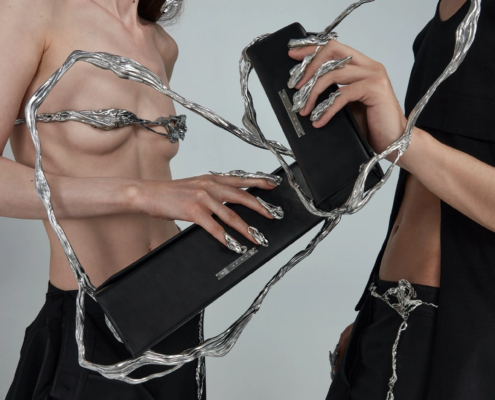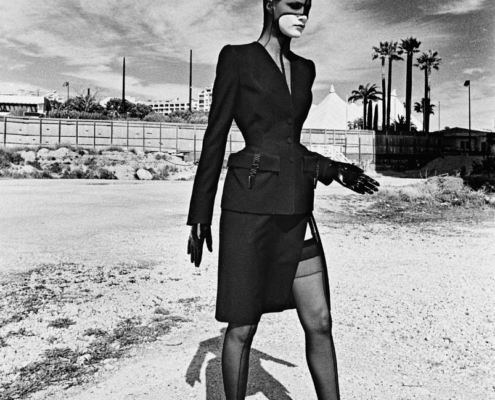The first thing you are going to ask yourself is this: ‘but can I actually ever wear this?’ A valid line of questioning– to the average consumer, a digitized wardrobe feels neither accessible nor practical in a world where societal custom still demands corporeal adornment. But the better question is not “can I?”, but how I… as virtual reality has indeed been realized. What’s revolutionizing is not the technology itself, but how modes of this new terrain have unquestionably redefined how the fashion industry operates.
No matter how far away our childhood speculations of dawning daily spacesuits, Jetson-esque latex, silhouetting superpowers, or however we pondered our forthcoming fashion, we cannot deny that we are already standing in the future; a society more immersed in technology than ever before. Virtual reality at its very beginning was meant to change the world and then it didn’t do quite that. Recall the gawky machinery of the Oculus Rift or the objectively unflattering Google Glass (“Glasshole” was a common insult hurled within tech circles at the point of its release). These products remained to most consumers little but the sci-fi accessories of Silicon Valley CEOs. But now, as we are reckoning with the insatiability, wastefulness, and exhaustion of the trend-to-trash cycle, the dephysicalization of the fashion experience has appeared with the zing of urgency and innovation the fashion industry needs. And a plethora of savvy brands and designers have already tapped into this vision to create a new iteration of virtual reality’s potential.
Nike in particular amassed major attention over their recent launch into the metaverse. The Nikeland showroom popped up on the Roblox platform to provide a new demographic of virtual consumers with downloadable virtual goods, online non-downloadable virtual footwear, and an interactive website and computer application software for virtual reality game services. In addition to this feat, Their acquisition of RTFKT–a digital collectible startup that according to the global brands website “leverages the latest in game engines, NFTs, blockchain authentication and augmented reality to create one of a kind virtual products and experiences.” The brand’s latest moves show a distinct dedication to investing and expanding the digital fashion frontier.
Instead of celebrities and tech magnates, these latest products provide a different type of exclusivity, accessible to the growing range of consumers who find themselves in virtual reality.
Not to be outdone, rival sportswear titan Adidas revealed that it acquired space on virtual gaming platform The Sandbox and seeks to join forces with the NFT brand Bored Ape Yacht Club, NFT comic series Punks Comic, and cryptocurrency investor Gmoney. Even luxury brands can’t deny the lure of the metaverse with Diesel and Margiela-owner OTB Group’s announcement that it is launching a new business unit “dedicated entirely to the development of products, projects and experiences” designed for the metaverse. Designers who typically show at the most major fashion weeks are now further experimenting with augmented reality for their virtual runways. Balenciaga was among the first to host a virtual reality runway show which they presented through Oculus glasses and paired with the launch of their own NFT. Colina Strada, Gypsy Sport, and Mowalola all showed on IMVU, an online metaverse and social networking site where users create personal avatars they may dress in clothing designed by fellow creators bought with credits paid for with real currency. IMVU grew by 44% during the pandemic; it now attracts 7 million active users a month. The point of IMVU and similar metaverses is to connect virtually with friends and to potentially make new ones, but shopping is no small part of the site’s attraction. “Fashion is at the epicenter of why people create avatars and connect with others on IMVU,” says Lindsay Anne Aamodt, the site’s senior director of marketing. IMVU’s virtual store features 50 million items made by over 200,000 creators. Fourteen billion in credits, or $14 million, exchanges hands over 27 million transactions each month–that’s some major real-world cash amalgamated through virtual means.
These newfangled tech-fashion unions seem to respond to society’s boredom or disappointment with the experiences offered to us in this material reality. The above strings of metaverse-focused moves are proof that virtual reality will continue to take a more prominent place in companies’ branding efforts, potentially setting the stage for these experiences and virtual goods to add real might to brands’ and luxury goods powerhouses’ revenue-generating activities. Not only are the clothes we wear changing, but the way we experience clothing in general is changing. It’s a harsh world that we live in, it’s easy to see why brands are investing in turning inanimacy into experience in the freshest ways possible. In the same way fantasy is for imagining the possibilities of new worlds, digital fashion explores the extent of fashion as both a requirement we are going to increasingly need to tweak to our environment, as well as an outward expression of our identities to the world. When you don’t have actual access to these things physically, when the absurd price of dressing is unrealistic and exhausting, it’s tantalizing to dress yourself as a sim. Everything fits, everything is yours at a touch, and now more than ever, you can finally perfect the “real” self you want to be.







